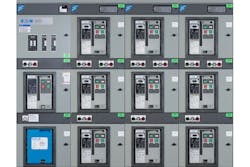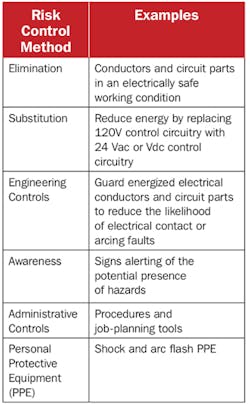Q&A with Eaton’s Adams Baker: Addressing arc flash safety in process industries
What are the arc flash risks in process industries and how can they be addressed?
Arc flash hazards are ever-present around energized electrical equipment. Whenever a piece of electrical equipment changes state, such as when a breaker is closed, a motor is started or equipment is re-energized after maintenance, there is a risk for an arc flash event. Even equipment that is operating in a steady-state condition has some risk. For example, normal vibrations from energized equipment can cause tools or bolts that were accidentally left inside after a maintenance activity to move and fall across current-carrying conductors — potentially causing an arc flash event. As equipment warms up and cools down, over time the bolted electrical connections can loosen and eventually start arcing. And animals are sometimes attracted to the warmth of energized equipment, potentially causing an arc flash if they enter the enclosure and cross live conductors.
That said, arc flash events do not occur spontaneously in electrical equipment. They result from factors that can, for the most part, be controlled, i.e., correct installation, controlled environment, regular maintenance, proper maintenance practices and protecting electrical equipment from foreign matter such as conductive dust, water moisture and rodents. However, arc flash remains a concern in the industry, and enhancing safety in the workplace continues to be a critical priority.
A great place to start when addressing the risk of arc flash is with the National Fire Protection Association (NFPA) 70E, Standard for Electrical Safety in the Workplace. An important addition to the 2018 version is the inclusion of the "Hierarchy of Risk Control." The hierarchy, as found in Informative Annex F, Table F.3, is shown in Figure 1, in order from most effective to least effective1:
Figure 1. Hierarchy of risk control
The basic idea is that removing the hazard altogether is the best solution, and relying on personal protective equipment (PPE) should be the last line of defense. And while hazard elimination via de-energizing electrical equipment is the best method, the equipment will eventually have to be re-energized, so the hazard remains. Therefore, it is necessary to find a different way to reduce the risk. As a result, the industry tends to focus on "engineering controls" to reduce risk to an acceptable level.
What codes and standards need to be considered related to arc flash safety?
In addition to NFPA 70E, there is another important section of code that deals with arc flash safety: The National Electric Code (NEC), Section 240.87, which states that electrical systems that have a circuit breaker rated for, or can be adjusted to, 1,200 amps or higher must use a method to reduce the clearing time. The section then lists seven approved methods; all of which are considered engineering controls to reduce the clearing time. The methods include:
- Zone-selective interlocking
- Differential relaying
- Energy-reducing maintenance switching with local status indicator
- Energy-reducing active arc flash mitigation system
- An instantaneous trip setting that is less than the available arcing current
- An instantaneous override that is less than the available arcing current
- An approved equivalent means
In terms of equipment standards that should be considered when purchasing new electrical gear to improve arc flash safety, the primary one is the ANSI/IEEE C37.20.7, "Guide for Testing Switchgear Rated up to 52 kV for Internal Arcing Faults." This test guide describes how switchgear manufacturers must intentionally ignite an arcing fault inside the equipment being tested and what constitutes a test pass. Specifically, it defines a successful outcome of an internal arcing fault test using a set of five criteria summarized in the following:
- That properly latched or secured doors, covers, etc., do not open.
- No fragmentation of the enclosure occurs within the time specified for the test.
- That arcing does not cause holes in the freely accessible front, sides and rear of the enclosure (known as a "Type 2" rating).
- That no indicators ignite as a result of escaping gases. (Cotton indicators are placed 4 inches from all sides of the equipment to simulate someone standing by the equipment in cotton clothing.)
- That all of the grounding connections remain effective.
What does it mean when a product is "arc-resistant?"
Generally speaking, if a piece of equipment is labeled as arc-resistant, it has passed the testing criteria previously described and will provide protection to personnel working in the vicinity of the equipment in the event of an arc flash, but with a few important caveats.
Traditional arc-resistant equipment is constructed using a heavily reinforced enclosure that is designed to contain the arc blast and redirect it away from personnel and upward through plenums and out of the room via ducts. However, there are two important considerations about this design paradigm that must be understood. First, if a door on the equipment is left open or is improperly latched or if a panel has been removed, the equipment is no longer arc-resistant and will not protect personnel from the arc blast. This is because the equipment enclosure will not be able to contain and redirect the blast, and instead, the energy will escape through the opening in the enclosure. Second, traditional arc-resistant equipment may sustain heavy internal damage in the event of an arc flash, requiring significant downtime and expense to repair or replace it.
Are there other recommended methodologies for improving arc flash safety?
New, innovative arc quenching switchgear provides arc-resistant protection without the need for ducts, plenums, venting into the room or special enclosure construction. It can even provide arc-resistant protection if breakers are removed, doors are open or panels are removed, and all while protecting the switchgear itself from arc flash damage. Arc quenching switchgear is considered an "engineering control" per the Hierarchy of Risk Control. It is tested to the C37.20.7 test guide, and it satisfies Method 4 of the NEC Section 240.87.
Arc quenching switchgear is able to detect and contain an arc fault in less than 4 milliseconds, drastically reducing the incident energy. It works by detecting the ignition of an arc inside the switchgear using an arc flash relay and transferring the arc to an arc quenching device. Arc quenching switchgear transfers the arc by creating a lower impedance arcing fault, not a bolted fault, safely contained inside the arc quenching device. This reduces the peak fault current by at least 25 percent and puts less stress on upstream equipment during a quenching operation.
How can a plant manager justify investment in modern arc flash safety equipment and practices?
It is estimated that 5 to 10 arc flash incidents occur every day in the U.S. The average direct costs of an incident start at approximately $80,000 and balloon into millions of dollars when indirect costs are considered.2 Therefore, even in the best-case scenario when no one is injured, avoiding just a single arc flash accident can easily justify the additional cost of arc flash safety equipment if the electrical equipment is protected from damage and downtime is minimized. New solutions, such as arc quenching switchgear, can do just that: Drastically reduce incident energy to enhance arc flash safety and protect the switchgear from arc flash damage, thereby minimizing process downtime.
References
- NFPA 70E, Standard for Electrical Safety in the Workplace, 2018 Edition.
- Campbell, Richard B. and Dini, David A., Occupational Injuries from Electrical Shock and Arc Flash Events, Fire Protection Research Association, March, 2015. www.nfpa.org.
Adams Baker is the product manager for Eaton’s low-voltage switchgear product line. He has a Bachelor of Science in mechanical engineering from Dartmouth College and a master’s in engineering management. He has been involved with industrial product development for more than a decade.


